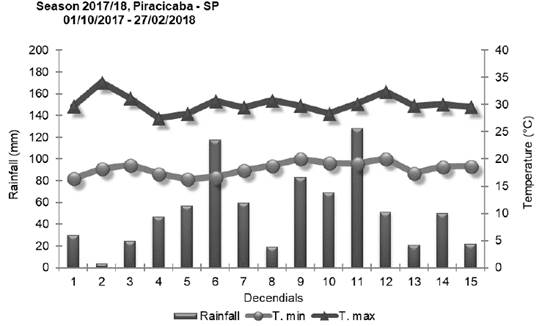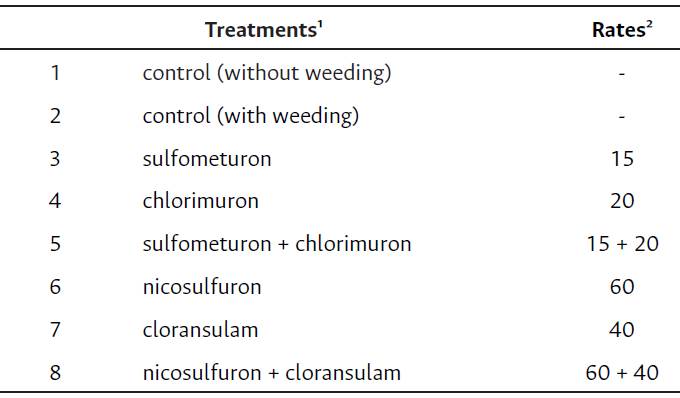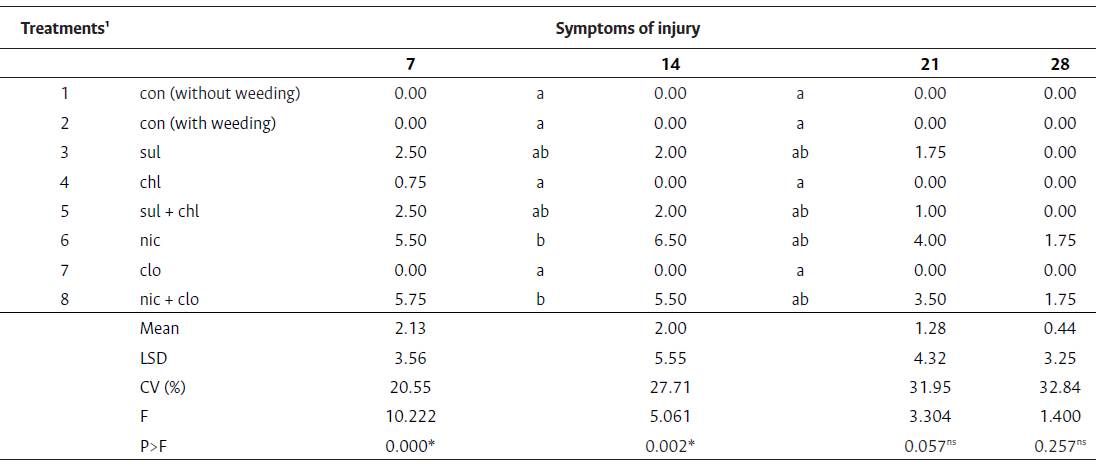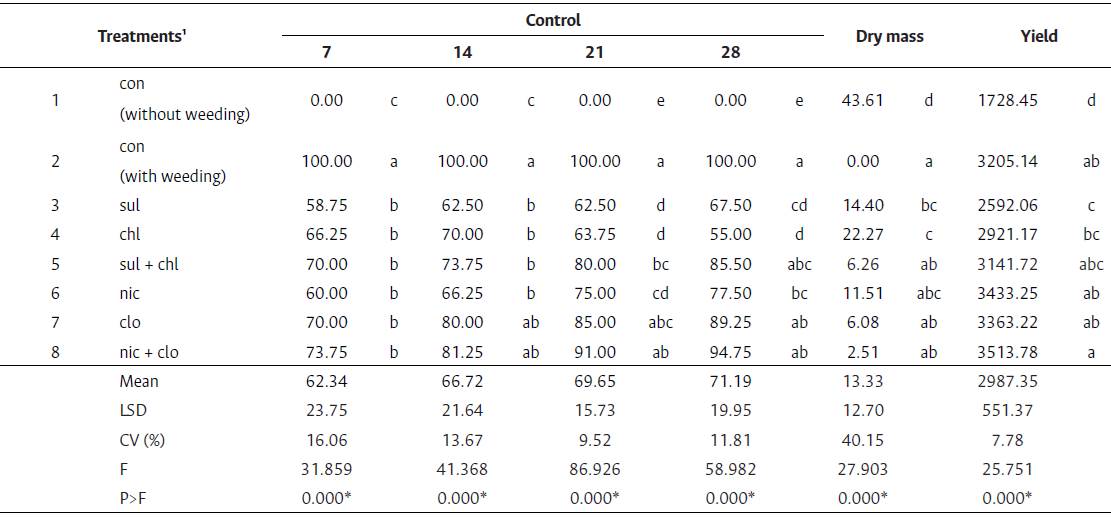Introduction
Glyphosate is a post-emergence herbicide, belonging to the chemical group of substituted glycines, classified as non-selective (selective only for tolerant transgenic crops). It has a broad spectrum of action and systemic action (Duke, 2018). It inhibits the activity of the enzyme 5-enolpyruvylshiquimate-3- phosphate synthase (EPSPs), which is a catalyst for synthesis reactions of aromatic amino acids plant essential, such as: phenylalanine, tyrosine, and tryptophan (Galli & Montezuma, 2005; Duke, 2018).
Transgenic glyphosate tolerant soybeans (Roundup Ready®-RR® soybeans) was developed through the introduction of a gene called cp4-EPSPs from the bacterium Agrobacterium tumefaciens strain CP4 (Albrecht et al., 2021). This gene encodes an enzyme EPSPs glyphosate insensitive (Padgette et al., 1995). The “second generation" of RR soybean (RR®2 soybean) was developed through a different technique of insertion of the cp4-EPSPs gene (in addition to the crylAc gene, from the bacterium Bacillus thuringiensis (Bt), which makes insects resistant), under the trademark Intacta™ Roundup Ready™ 2 Pro (Bernardi et al., 2012). With the advent of glyphosate tolerant-crops the use of glyphosate was intensified, which increased the selection pressure of weed biotypes resistant to this herbicide (Heap & Duke, 2018).
There are currently 54 weed species with reported cases of glyphosate resistance biotypes worldwide (Heap, 2022). Weed management to prevent the selection of herbicide resistant biotypes should be preventive, using the association and herbicide rotation of different mechanisms of action (Heap & Duke, 2018) and other management strategies beyond chemical control. In this context, soybean tolerant to other mechanisms of action such as inhibitors of the enzyme acetolactate synthase (ALS), auxin mimics, glutamine synthetase (GS) inhibitors, among other mechanisms deserve prominence in the prevention of selection of glyphosate resistant biotypes (Travlos et al., 2020). Thus, sulfonylurea-tolerant soybean (STS®) that has a high tolerance to some herbicides of this chemical group, such as chlorimuron and nicosulfuron, can be highlighted.
Sulfonylurea-tolerant soybean is not a transgenic crop, it was developed through the technique of seed mutagenesis (Walter et al., 2014). Mutant seeds from the ‘Williams 82' soybean cultivar were selected according to tolerance to chlorsulfuron sulfonylurea. Thus, the soybean cultivar W20 STS was developed, which presented high tolerance, in post and pre- emergence, for some sulfonylureas (Sebastian et al., 1989). This tolerance is conferred by two semi- dominant alleles, Als1 e Als2 (Mantovani et al., 2017; Walter et al., 2014).
Sulfonylureas have the mechanism of inhibiting ALS enzyme, interrupting the synthesis of the branched amino acids (leucine, isoleucine, and valine) (Duke et al., 2019). Consequently, protein synthesis is interrupted, which in turn interferes with DNA synthesis and cell growth. After absorption, the sulfonylureas are translocated to meristems and apexes, which are areas of active growth, susceptible plants have the growth inhibited. Sensitive plants become chlorotic, deplete and die within 7 to 14 days after application (Zhou et al., 2009). Control mainly eudicotyledons weeds and some molecules also acts on Cyperus sp. (Schloss, 1990). Acetyl-coenzyme A carboxylase (ACCase) inhibitor herbicides are also important in controlling weeds in soybean. They are readily absorbed by plant foliage, and the translocation varies from species to species, but can occur both by phloem and xylem, and present action on monocotyledonous weeds (Thill, 2003).
Herbicides of other mechanisms of action may be effective in controlling weeds in RR2/STS soybeans, it is believed that ALS inhibitor herbicides in association with ACCase inhibitors can be used as an alternative to glyphosate in weed control in RR/ STS soybeans. The aim of this study was to evaluate the efficacy of ALS inhibitor herbicides in association with haloxyfop in weed control for post-emergence (V4) application of RR/STS soybean.
Materials and methods
Study area
The experiment was carried out in the 2017/18 season, in an area located in the city of Piracicaba-SP. It was used the cultivar BMX Garra RR2/STS, which presents indeterminate growth habit and relative maturity group 6.3. By the classification of Koppen the climate of the region is characterized as Cwa-humid subtropical with drought in the winter (Aparecido et al., 2016). The distribution of rainfall and temperature along the conduction period of the experiment is presented below (Figure 1).

Figure 1.Rainfall (mm), máximum temperature (°C) and minimum (°C) during the the experiment. Source: LEB-USP/ESALQ.
The fertilization was applied to correct the soil, considering the extraction of the crop. Seeding was carried out in the second half of October 2017. The physical and chemical analysis of the soil of the experimental area is presented below (Table 1). The area of the experiment was infested mainly by the weeds Alternanthera tenella, Bidens sp., Sorghum halepense, Eleusine indica, and Digitaria sp.
Experimental design and treatments
The treatments were composed by the application of herbicides described in Table 2. The experimental design was a randomized block, with four replications. The experimental units consisted of five-meter-long plots with five soybean rows, spaced at 0.45 m, the three central lines being considered useful area, discarding the first and last meter of the plot.
Table 2 Post-emergence treatments of glyphosate and sulfonylurea- tolerant soybean. Season 2017/18

1sulfometuron (Curavial®), chlorimuron (Classic®), nicosulfuron (Sanson® 40 SC), cloransulam (Pacto®). Addition of haloxyfop (Verdict® R) at rate 60 g a.e. ha-1, and oil according to the label recommendations for herbicide treatments.2 Rates in grams of active ingredient per hectare (g a.i. ha-1).
The spraying was via CO2 pressurized backpack sprayer, with bar equipped with four spray nozzles (XR 110.02) at a constant pressure of 200 kPa, a flow rate of 0.65 L min-1, working at a height of 50 cm from the target and a speed of 1 m s-1, an applied range reaching 50 cm wide by spray nozzle, providing a spray volume of 200 L ha-1.
Data collection
At 7, 14, 21, and 28 days after application (DAA) was realized the evaluation of weed control and symptoms of injury in soybean plants, percentages visual grades were assigned ranging from 0 to 100 % each experimental unit, where 0 represents absence of injury and 100 % death of plants (Velini et al., 1995). At 28 DAA the weed shoot part was collected from an area of 0.25 m2 of each plot. The collected material was dried in a forced ventilation oven at 65° C for 72 hours, after which the dry mass of the weeds was measured in analytical balance with precision of two decimal places.
For the evaluation of yield, plants were harvested from the two central lines, discarding the first and last meter of the plot, totalizing a seasoned area of 2.7 m2. The plants were in the R8 stage, that is, 95 % of the pods had the typical color of mature pods. In sequence, the pods were threshed on threshing for experiments and cleaned with the aid of sieves. The grains produced in each parcel had their mass measured and the moisture corrected to 13 %, from these data the yield in kg ha-1 was calculated.
Statistical analysis
The data were submitted to analysis of variance by F-test (P < 0.05). The means of the treatments were compared by the Tukey’s test (P < 0.05) (Pimentel-Gomes & Garcia, 2002).
Results
Symptoms of injury
Visual symptoms of injury were observed in soybean plants, mainly for application of nicosulfuron (60 g a.i. ha-1) and nicosulfuron + cloransulam (40 g a.i. ha-1), in association with haloxyfop (60 g a.e. ha-1). However, symptoms of no more than 6.5 % were found for nicosulfuron at 14 DAA. In the following evaluations no differences between treatments were observed (Table 3).
Table 3 Symptoms of injury (%) for soybean pLants at 7, 14, 21, and 28 DAA of herbicides at post-emergence. Season 2017/18, Piracicaba-SP

1con (control), sul (sulfometuron-15 g a.i. ha-1), chl (chlorimuron-20 g a.i. ha-1), nic (nicosulfuron-60 g a.i. ha-1), clo (cloransulam-40 g a.i. ha-1). Addition of haloxyfop (60 g a.e. ha-1), and oil according to the label recommendations for herbicide treatments.
*Means followed by the same Letter in column are not different by Tukey test (P < 0.05). ns non-significant (P < 0.05).
Weed control
Differences were verified between treatments for weed control in all evaluations, as well as for weed dry mass (Table 4). At 7 DAA no differences were observed between herbicide treatments. All showed a higher percentage of control than the weed control treatment. The maximum percentage of control (73.75 %), in absolute values, was observed for the application of nicosulfuron + cloransulam + haloxyfop (60 g a.e. ha-1).
The weed control for cloransulam + haloxyfop (80 %) and nicosulfuron + cloransulam + haloxyfop (81.25 %), the only herbicide treatments that did not differ from the control (with weeding), was maintained up to 14 DAA, which was kept free of interference of weeds.
Similarly, at 21 DAA, highlight again for cloransulam + haloxyfop and nicosulfuron + cloransulam + haloxyfop, with controls of 85 and 91 %, respectively, with no differences for the control treatment (100 %). The application of sulfometuron (15 g a.i. ha-1) + chlorimuron (20 g a.i. ha- 1) + haloxyfop reached 80 % of control, statistically lower only than the control (with weeding). At 28 DAA no differences were observed between weed control and cloransulam + haloxyfop (89.25 %), nicosulfuron + cloransulam + haloxyfop (94.25 %) and sulfometuron + chlorimuron + haloxyfop (85.5 %) treatments. The efficacy of weed control of these treatments is highlighted.
All herbicide treatments reduced the weed dry mass compared to the control (without weeding). While the application of sulfometuron + haloxyfop and chlorimuron + haloxyfop presented a higher dry mass value compared to the weed control treatment (0.00 g), other herbicide treatments did not differ from the control (with weeding).
Yield
The yield of soybean plants was higher in all herbicide treatments compared to the control (without weeding). Differences between herbicide treatments were also observed. The yield of the soybean plants submitted to the application of nicosulfuron + cloransulam + haloxyfop is higher than that verified for application of sulfometuron + haloxyfop and chlorimuron + haloxyfop. These results agreed with those verified for weed control and dry mass. For the application of sulfometuron + haloxyfop, it was observed that it was the only one among the herbicide treatments that presented lower yield than the control (with weeding), which is also in agreement with that observed for weed control and dry mass (Table 4).
Table 4 Weed control (%) at 7, 14, 21, and 28 DAA, dry mass of weeds (g) and yield (kg ha-1) under post-emergence herbicide application. Season 2017/18, Piracicaba-SP

1 con (control), sul (sulfometuron-15 g a.i. ha-1), chl (chlorimuron-20 g a.i. ha-1), nic (nicosulfuron-60 g a.i. ha-1), clo (cloransulam-40 g a.i. ha-1). Addition of haloxyfop (60 g a.e. ha-1), and oil according to the label recommendations for herbicide treatments.
*Means followed by the same Letter in column are not different by Tukey test (P < 0.05). ns non-significant (P < 0.05).
Discussion
Noteworthy are the results checked for association nicosulfuron + cloransulam + haloxyfop, which appeared effective in controlling weeds and selective for soybean plants. This association is not usual, since the herbicide nicosulfuron is only recommended for maize crop (Rodrigues & Almeida, 2011), and is not selective for soybean (non-STS).
Manley et al. (2001) found that the application of imazaquin (140 g a.i. ha-1) in pre-planting followed by the post-emergence application of nicosulfuron (35 g a.i. ha- 1) in STS soybean was effective in the control of Chenopodium album, Ambrosia artemisiifolia, Datura stramonium, and Amaranthus sp. over four years of season. In this study, symptoms of injury were verified, however no reductions in soybean yield were observed.
Albrecht et al. (2017) did not observe symptoms of injury and reduced yield of the cultivar CD 250 RR/ STS for the application of nicosulfuron, in post- emergence (V4) up to the rate 200 g a.i. ha-1. Silva et al. (2016) observed symptoms of injury of at most 5.5 % for post-emergence application of nicosulfuron (60 g a.i. ha-1), alone or in combination with glyphosate (960 a.e. ha-1), and did not verify reductions in yield of cultivar CD 2630 RR/STS. In the same study was verified selectivty to the application of chlorimuron (20 g a.i. ha-1) and cloransulam (40 g a.i. ha-1) isolated in association with glyphosate. Other studies have also observed the selectivity and/or efficacy of sulfonylureas in STS soybeans (Albrecht et al., 2018; Silva et al., 2018; 2019; 2020), as observed in the present study.
In the present study, the herbicide chlorimuron was selective and effective in controlling weeds in association with sulfometuron and haloxyfop. Piasecki and Rizzardi (2016) also observed the efficacy and selectivity of chlorimuron + sulfometuron for pre-emergence application in the cultivar BMX Turbo RR/STS.
The application of chlorimuron (10 g a.i. ha-1) in association with glyphosate caused symptoms of injury in non-STS soybean, but without reductions in yield (Maciel et al., 2009), while application of glyphosate + chlorimuron (960 g a.e. ha- 1 + 25 a.i. ha- 1) caused a yield reduction in non-STS soybean (Albrecht et al., 2012).
Associations of ACCase inhibitor herbicides, such as haloxyfop, with ALS inhibitor herbicides are important in controlling weeds in soybean, especially in a view of the progress of resistant and tolerant weeds to glyphosate in this crop. As previously mentioned, the association between haloxyfop and nicosulfuron is not usual, since nicosulfuron is not selective for non-STS soybean cultivars. These two herbicides + cloransulam were effective and selective to soybean STS, characterizing themselves as alternatives to glyphosate in the management of weeds in soybean with this technology.
With the advent of Enlist™ maize the association haloxyfop + nicosulfuron can be used in the management of weeds in this crop with this technology. Enlist maize has tolerance to herbicide 2,4-D due to the enzyme aad-1, this enzyme also confers tolerance to haloxyfop (Wright et al., 2010). Thus, the results for weed control of this association in the present work are also important in this case. However, it is necessary to study the association of haloxyfop + nicosulfuron in Enlist maize, evaluating efficacy and selectivity.
Conclusion
The associations between the herbicides ALS inhibitors and haloxyfop applied in post-emergence (V4) of the soybean cultivar BMX Garra RR2/STS were effective in weed control. Associations of ACCase and ALS inhibitor herbicides are important in controlling weeds in soybean, especially in a view of the progress of resistant and tolerant weeds to glyphosate in this crop. The association between haloxyfop and nicosulfuron is not usual, since nicosulfuron is not selective for non-STS soybean cultivars.















